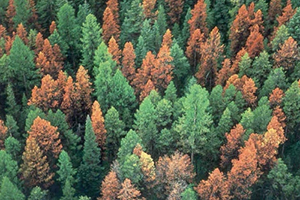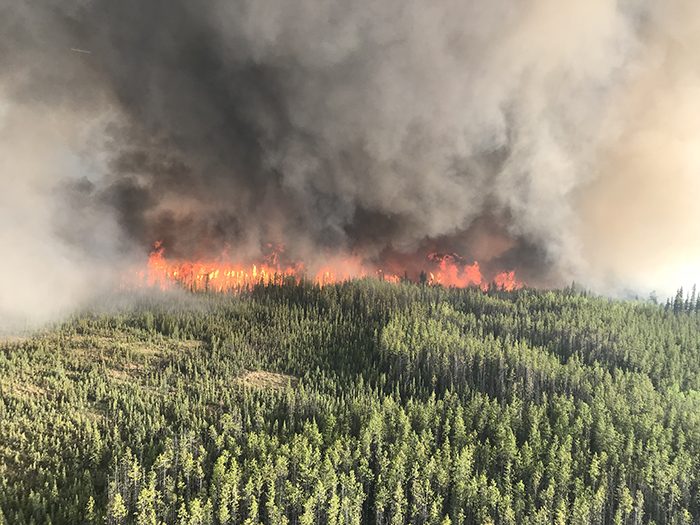Wildfires are lasting longer and becoming more intense, threatening communities year-round. Rising temperatures, prolonged droughts, insect infestations, and extreme weather events are stressing forests across Canada and the U.S., making them more vulnerable to larger, faster-moving fires that threaten ecosystems and communities alike.

Climate change is also increasing the risk and severity of droughts in parts of Canada, further stressing forests, and increasing their susceptibility to devastating wildfires. Recent catastrophic wildfires in Jasper and Los Angeles serve as stark reminders of these growing risks.
While headlines often link all fire with destruction, it is less known that fire can be used to mitigate wildfires through prescribed burnings. A prescribed burn is a planned fire used to reduce flammable materials and releasing nutrients back to the soil. improving fire resilience and forest health. Fire presents both challenges and opportunities, offering a tool that, when harnessed strategically, helps regenerate, rejuvenate, and protect our forests. Notably, Indigenous communities across North America use strategic prescribed fire to sustain healthy lands and mitigate wildfire risks.
SFI and Project Learning Tree Canada recognize the value of this expertise and actively promotes fire resiliency through the SFI Forest Management Standard, which includes measures to limit the unwanted impacts of fire across the more than 150 million hectares/370 million acres of SFI-certified forests. The SFI Indigenous Peoples and Families Module in Canada also provides an opportunity for small-scale Indigenous forest managers to benefit from the economies of scale afforded by working in a group rather than individually. While designed with Indigenous communities in mind, the module is also available to any small woodlot owner.
The Role of Indigenous Fire Stewardship
Many Indigenous communities across North America (also known as Turtle Island), have long understood the nuanced role of fire in forest management and cultural practices. For millennia, Indigenous Peoples have practiced controlled, deliberate burns to protect land from wildfire, promote growth of food, attract game animals, and support healthier ecosystems. These practices reflect an intimate knowledge of the land, demonstrating that fire, when used with care, can be a powerful force for good.
As we face growing wildfire risks, it is crucial to integrate Indigenous fire stewardship into modern forest management. SFI’s Indigenous Relations programs promote the recognition, value, and application of Traditional Knowledge.
Sustainable Forestry and Wildfire Mitigation

Photo credit: Alberta Forestry and Parks
Combining Indigenous stewardship practices and western science, sustainable forestry practices play a vital role in reducing wildfire risks. Responsible forest management—including thinning overgrown areas, removing dead trees, and implementing controlled burns—promotes forests health and resilience against climate change, invasive species, and other stressors.
The SFI Fire Resiliency and Awareness objective within the SFI Forest Management Standard promotes practices that help landowners and communities prepare for and effectively mitigate fire risks. Moreover, the controlled use of fire is fundamental to the regeneration of certain ecosystems. Examples of sustainable fire management can be seen, from the U.S. Southeast’s longleaf pine to Canada’s vast boreal forest. In the Southeast, controlled burns enhance seed dispersal and promote regrowth, making it an essential tool for the restoration of longleaf pine ecosystems. Across the continent, strategic fuel management and intervention help mitigate the increasing threat of wildfire across the boreal forest, while promoting the regeneration of some pyrophilic (“fire loving”) tree species. Forests in the southeast and far north, while different in composition, both exemplify how fire, when applied thoughtfully, can transform degraded landscapes into thriving, resilient ecosystems.
Moving Forward
Recognizing fire as a force for renewal is key to building landscapes that can withstand the challenges of a changing climate. As wildfires continue to have increasing economic and social impacts, embracing a holistic approach to fire management is more important than ever. By elevating and integrating Indigenous fire stewardship practices in sustainable forestry, we can harness fire as a tool for resilience rather than destruction. Strengthening these partnerships protects forests and communities while promoting Traditional Knowledge’s role in shaping a sustainable future.